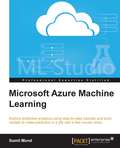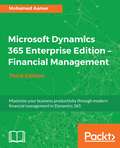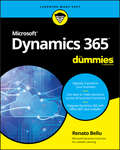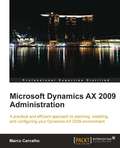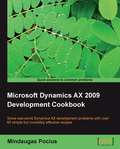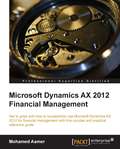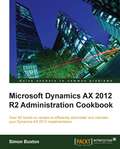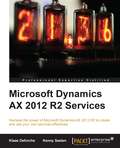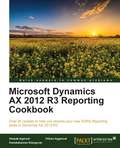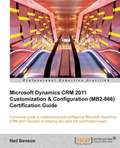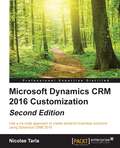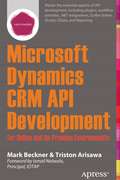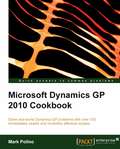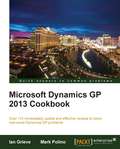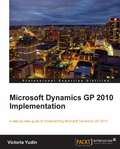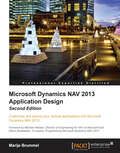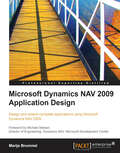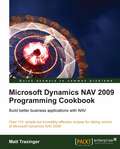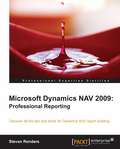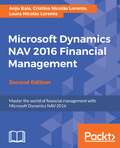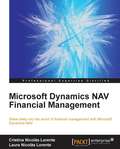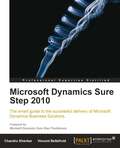- Table View
- List View
Microsoft Azure Machine Learning
by Sumit MundThe book is intended for those who want to learn how to use Azure Machine Learning. Perhaps you already know a bit about Machine Learning, but have never used ML Studio in Azure; or perhaps you are an absolute newbie. In either case, this book will get you up-and-running quickly.
Microsoft Corp.: The Introduction of Microsoft Works
by Thomas J. KosnikMicrosoft must decide how to design a new software product for global markets, identify the timing for entry into different countries, and position the product around the world.
Microsoft Dynamics 365 Enterprise Edition – Financial Management: Maximize your business productivity through modern financial management in Dynamics 365, 3rd Edition
by Mohamed Aamer Ala El DinBoost your accounting and financial skills with Microsoft Dynamics 365Key FeaturesMake real-time data-driven decisions for your enterprise with Microsoft Dynamics 365 Enterprise editionConfigure and set up the Microsoft Dynamics 365 financial module via highly useful tips and tricksAdminister customer relations and plan enterprise resources with this systematic guideBook DescriptionMicrosoft Dynamics 365 for finance and operations is a rapidly growing application and is widely used in enterprise organizations. Because of its ability to maximize business productivity, it is a fast-growing business application package in the ERP market.We will start by looking into ERP concepts, implementation needs, and interface design, giving you basic knowledge of financial management aspects and explaining key concepts along the way. To begin with, you'll be taken through the general ledger and financial dimension functions. You'll later learn about the sales tax mechanism and multi-currency in Microsoft Dynamics 365. We tackle each topic with focused examples and explanations on topics such as payable/receivable accounts, forecasting, cash and bank management, budgeting planning/control, and fixed assets. Finally, we walk you through intercompany, consolidation, costing basics, and financial reporting.By the end of this book, your finance team will have a much richer understanding of Microsoft Dynamics 365 for finance and operations and its powerful capabilities.What you will learnExamine the business logic behind the financial functionalities of Microsoft Dynamics 365 FFOSet up and configure the core modules of financial managementGrasp the key control points of financial managementExplore intercompany and consolidation in Microsoft Dynamics 365 FFOUnderstand multi-currency sales, tax mechanisms, and budgeting capabilities in Microsoft Dynamics 365 FFOGet to grips with month/year-end period close functionalityUnderstand the account payable and receivable moduleUse Microsoft Dynamics 365 to create financial reportsWho this book is forThis book is for application consultants, solution architects, controllers, CFOs, pre-sales and other professionals who are involved in a Microsoft Dynamics 365 for finance and operation implementation. Basic knowledge of financial terms, concepts, and terminologies is required.
Microsoft Dynamics 365 Extensions Cookbook
by Rami MounlaMore than 80 recipes to help you leverage the various extensibility features available for Microsoft Dynamics and solve problems easily About This Book • Customize, configure, and extend the vanilla features of Dynamics 365 to deliver bespoke CRM solutions fit for any organization • Implement business logic using point-and-click configuration, plugins, and client-side scripts with MS Dynamics 365 • Built a DevOps pipeline as well as Integrate Dynamics 365 with Azure and other platforms Who This Book Is For This book is for developers, administrators, consultants, and power users who want to learn about best practices when extending Dynamics 365 for enterprises. You are expected to have a basic understand of the Dynamics CRM/365 platform. What You Will Learn • Customize, configure, and extend Microsoft Dynamics 365 • Create business process automation • Develop client-side extensions to add features to the Dynamics 365 user interface • Set up a security model to securely manage data with Dynamics 365 • Develop and deploy clean code plugins to implement a wide range of custom behaviors • Use third-party applications, tools, and patterns to integrate Dynamics 365 with other platforms • Integrate with Azure, Java, SSIS, PowerBI, and Octopus Deploy • Build an end-to-end DevOps pipeline for Dynamics 365 In Detail Microsoft Dynamics 365 is a powerful tool. It has many unique features that empower organisations to bridge common business challenges and technology pitfalls that would usually hinder the adoption of a CRM solution. This book sets out to enable you to harness the power of Dynamics 365 and cater to your unique circumstances. We start this book with a no-code configuration chapter and explain the schema, fields, and forms modeling techniques. We then move on to server-side and client-side custom code extensions. Next, you will see how best to integrate Dynamics 365 in a DevOps pipeline to package and deploy your extensions to the various SDLC environments. This book also covers modern libraries and integration patterns that can be used with Dynamics 365 (Angular, 3 tiers, and many others). Finally, we end by highlighting some of the powerful extensions available. Throughout we explain a range of design patterns and techniques that can be used to enhance your code quality; the aim is that you will learn to write enterprise-scale quality code. Style and approach This book takes a recipe-based approach, delivering practical examples and use cases so that you can identify the best possible approach to extend your Dynamics 365 deployment and tackle your specific business problems.
Microsoft Dynamics 365 For Dummies
by Renato BelluAccelerate your digital transformation and break down silos with Microsoft Dynamics 365 It’s no secret that running a business involves several complex parts like managing staff, financials, marketing, and operations—just to name a few. That’s where Microsoft Dynamics 365, the most profitable business management tool, comes in. In Microsoft Dynamics 365 For Dummies, you’ll learn the aspects of the program and each of its applications from Customer Service to Financial Management. With expert author Renato Bellu’s clear instructions and helpful tips, you’ll be managing to your fullest advantage before you know it. Let’s get started! Digitally transform your business by connecting CRM and ERP Use data to make decisions across all business functions Integrate Dynamics 365 with Office 365 and LinkedIn Manage financials and operations Are you running a dynamic business? This book shows you how!
Microsoft Dynamics AX 2009 Administration
by Marco CarvalhoA practical tutorial, this book shows you how to set up and configure Dynamics AX 2009 and then how to improve and maintain its performance with clear step-by-step instructions, enabling Dynamics AX to fit your company's needs.If you are a network administrator or IT personnel charged with setting up and configuring Dynamics AX 2009 in your company, then this book is for you. A basic knowledge of Dynamics AX 2009 and general Windows Server Administration is required and familiarity with maintaining a SQL Server database server. Additionally, if you are a VAR tasked with implementing Dynamics AX into companies, then this book will provide you with a good overview and details of the whole Dynamics AX 2009 system.
Microsoft Dynamics AX 2009 Development Cookbook
by Mindaugas PociusThis book contains a list of useful Dynamics AX modifications – recipes – along with all required code and in-depth explanations. Most of the recipes are presented using real-world examples in a variety of Dynamics AX modules. The step-by-step instructions along with many useful screenshots make learning easier. This book is for Dynamics AX developers, and is primarily focused on delivering time-proven application modifications. Although new X++ developers could use this book along with their beginner guides, this book is focused more on people who are willing to raise their programming skills above the beginner level, and at the same time learn the functional aspects of Dynamics AX. So, some Dynamics AX coding experience is expected.
Microsoft Dynamics AX 2012 Financial Management
by Mohamed AamerThis book is a practical, hands-on guide that covers both the basic and advanced concepts of financial management using Microsoft Dynamics AX.Microsoft Dynamics AX Financial Management is for Microsoft Dynamics AX solution architects, application consultants, support engineers, pre-technical sales consultants, and project managers on the partner side, as well as chief financial officers, financial controllers, accounting managers, key users, business analysts, and chief information officers on the customer side. A basic knowledge of financial terms, concepts, and Microsoft Dynamics AX terminologies will help you better understand the concepts covered in this book.
Microsoft Dynamics AX 2012 R2 Administration Cookbook
by Simon BuxtonAn easy-to-follow guide full of hands-on examples of real-world administration tasks. Each topic is explained and placed in context, and for the more inquisitive, there are more details of the concepts used.If you are an administrator who provides IT support to Dynamics AX 2012 and IT managers then this book is ideal for you. Whether you are new to AX or an experienced professional wishing to add to your knowledge, then this book is for you. The book assumes a basic knowledge of using Dynamics AX and the Active Directory. Many of the examples in the book require that you have access to Dynamics AX as a System Administrator, local administrator of your local machine, and access to read your Active Directory
Microsoft Dynamics AX 2012 R2 Services
by Klaas Deforche Kenny SaelenThis book is a tutorial guide that covers each topic in depth with examples. The step-by-step approach will help you better understand each task as you will have to perform them frequently when utilizing the services. If you are a Dynamics AX developer, new or experienced who wants to implement services with Microsoft Dynamics AX 2012, then this book is for you. A basic understanding of MorphX and X++ is assumed, but the step-by-step instructions are easy to follow even for beginners. Some examples use C# and .NET, so experience with Visual Studio is a plus but not a must.
Microsoft Dynamics AX 2012 R3 Reporting Cookbook
by Deepak Agarwal Chhavi AggarwalMicrosoft Dynamics AX 2012 R3 Reporting Cookbook is recommended for Dynamics AX developers and .NET-based SSRS developers looking to familiarize themselves with the new AX reporting framework.
Microsoft Dynamics CRM 2011 Customization & Configuration (MB2-866) Certification Guide
by Neil BensonThis book is in the Enterprise certification series which means it is a hands-on guide with practical instruction, examples and all the information you will need to be successful in the exam, as well as 75 practice questions in the exam style. It includes practical advice on how to book the exam, approach the questions and maximize your score. "Microsoft Dynamics CRM 2011 Customization & Configuration (MB2-866) Certification Guide" is perfect for IT professionals and developers who work for a Microsoft partner or customer organizations. If you want to demonstrate your expertise and advance your career by obtaining Microsoft certification this book will provide you with the insight you need to succeed.
Microsoft Dynamics CRM 2016 Customization - Second Edition
by Nicolae TarlaUse a no-code approach to create powerful business solutions using Dynamics CRM 2016 About This Book * Latest guide on customizing your system using various features in Dynamics CRM 2016; * Highly practical, example-rich guide that gives you power to bend Dynamics CRM to maximize profits in your organization; * A no-code guide that is easy to follow for even non-programmers Who This Book Is For If you are new to Dynamics CRM or a seasoned user looking to enhance your knowledge of the platform, then this book is for you. It is also for skilled developers who are looking to move to the Microsoft stack to build business solution software What You Will Learn * Configure Outlook to integrate with your Dynamics CRM online instance * Manage the existing application structure by understanding how to extend and/or modify the modules and update the navigation * Find out how to use different entity views in order to get a 360-degree view of customer data * Map modern business processes to the platform to enhance the user experience * Use different Dynamics CRM processes such as dialogs, workflows, actions, and business process workflows * Use internal and external social data to enhance the user's ability to make the right decisions * Dive into generic administration options such as managing configuration and customization to become a power user In Detail Microsoft Dynamics CRM is a Microsoft solution to satisfy the various needs of customer relationship management and is already equipped to be flexible to meet the needs of businesses. With Microsoft Dynamics CRM 2016, many new features were added for social, marketing, sales, and integration with other tools. These features add many dimensions to customization. This book will not only showcase how CRM can be customized, but will also be your guide on how the latest advancements in Dynamics CRM 2016 can be used to benefit your business. You will learn how to enhance the functionality of Microsoft Dynamics CRM 2016 and use it to serve different businesses of various scales. You will see how to get ready to customize CRM and then quickly move on to grasp the CRM app structure, which will help you customize Dynamics CRM better. You will find out how to customize CRM for sales, service, marketing, and social. We'll also show you how CRM 2016 can be seamlessly embedded into various productivity tools, and how to customize CRM for machine learning and contextual guidance. Finally, we'll also cover the latest advancements in CRM's mobile capabilities and its complete offline support so you can better customize it. Style and approach Microsoft Dynamics CRM is a Microsoft solution for various needs of customer relationship management and is already equipped to be flexible to some extent as per the needs of the business. With Microsoft Dynamics CRM 2016, many new features for Social, marketing, sales, integration with other tools are added. These features add many dimensions to customization. This book will not only showcase how CRM can be customized but will also be a guide on how latest advancements in Dynamics CRM 2016 can be used for the benefit of your business.
Microsoft Dynamics CRM API Development for Online and On-Premise Environments
by Mark Beckner Triston ArisawaMicrosoft Dynamics CRM has a robust API that includes web services and an extensive SDK. As you develop CRM Plugins and custom integrations, you will find that there are many complexities and challenges associated with successfully interacting with this API. In order to ensure that you have all of the tools necessary to achieve success with CRM development, Microsoft Dynamics CRM 2011 API Development presents the essential aspects of API development including plugin development and registration. In addition to Plugins, you will work through building out several integrations that work with both the SDK and the Web Service layer. You will also build a C# application that creates records within CRM using the API, work with Scribe Online for integration and migration, design reports that read data from CRM using FetchXML, and interact with the OData REST service using JScript. Once you've worked through the various topics presented, you will find that you will have the advanced skills required for working with CRM 2011 Online and On Premises. Foreword by Ismail Nalwala, Principal, IOTAP.
Microsoft Dynamics GP 2010 Cookbook
by Mark PolinoAs a cookbook, this book enables you to solve real-world Dynamics GP problems with immediately useable recipes that unleash the powerful functionality of Dynamics GP. The book provides tips, techniques, and solutions designed to show users how to improve their use of Dynamics GP, not simply perform basic tasks. If you are a Dynamics GP user or Dynamics GP partner primarily focused on delivering time-proven application optimizations, then this book is for you. This book assumes that you have a basic understanding of business management systems, with basic knowledge of Microsoft Dynamics GP. All the recipes are real-world tested and designed to be used immediately.
Microsoft Dynamics GP 2013 Cookbook
by Ian Grieve Mark PolinoMicrosoft Dynamics GP 2013 Cookbook is a highly practical beginner to intermediate Cookbook to improve your efficiency and master your use of Microsoft Dynamics GP 2013. All the recipes are time-proven; real-world tested, and designed to be used immediately.If you're a Dynamics GP partner or Dynamics GP user, primarily focused on delivering application optimizations, then "Microsoft Dynamics GP 2013 Cookbook" is for you.This book assumes that you have a basic knowledge of Microsoft Dynamics GP, a basic understanding of business management systems, and some exposure to Microsoft SQL Server.
Microsoft Dynamics GP 2013 Implementation
by Victoria YudinA step-by-step guide for planning and carrying out your Microsoft Dynamics GP 2013 implementation. Detailed descriptions and illustrations of setup screens and practical examples and advice are included for the Dynamics GP system and core modules.If you are a new or existing Microsoft Dynamics GP consultant or an end user who wants to implement, install, and set up core modules of Dynamics GP 2013, then this book is for you. A basic understanding of business management systems and either Dynamics GP or a similar application is recommended.
Microsoft Dynamics NAV 2009 Application Design: Customize and extend your vertical applications with Microsoft Dynamics NAV 2013, 2nd Edition
by Mark BrummelThis book is a tutorial in an easy-to-read style. It will show Dynamics NAV developers how to create applications of different kinds with sufficient examples throughout. If you are a NAV consultant and developer, or designer of business applications you will benefit most from this book. The book assumes that you have a basic understanding of business management systems and application development, with a working knowledge of Microsoft Dynamics NAV.
Microsoft Dynamics NAV 2009 Application Design: Design and extend complete applications using Microsoft Dynamics NAV 2009
by Mark BrummelThis book is a tutorial in an easy-to-read style. It will show Dynamics NAV developers how to create applications of different kinds with sufficient examples throughout. If you are a NAV consultant and developer, or designer of business applications you will benefit most from this book. The book assumes that you have a basic understanding of business management systems and application development, with a working knowledge of Microsoft Dynamics NAV.
Microsoft Dynamics NAV 2009 Programming Cookbook
by Matt TraxingerYou won't find any fluff here. This book is written in a direct, to-the-point style to help you get what you need and continue working in NAV. At the same time it provides enough explanation so that you understand what we are doing and why it is necessary.In many programming books you will find yourself searching through paragraph after paragraph to try to find what you are looking for. That's not the case here. Each recipe starts with a short description of what it will teach. It is immediately followed with directions, usually with illustrations, of how to perform the task. You will find the explanation of the code at the end, along with some advice for further reading or other tasks you might be interested in.If you are a junior / entry-level NAV developer then the first half of the book is designed primarily for you. You may or may not have any experience programming. It focuses on the basics of NAV programming. It would be best if you have gone through a brief introduction to the NAV client.If you are a mid-level NAV developer, you will find the second half more useful. These chapters explain how to think outside of the NAV box when building solutions.There are also recipes here and there that senior developers will find useful.
Microsoft Dynamics NAV 2009: Professional Reporting
by Steven RendersThis book doesn't assume any prior experience with Dynamics NAV reporting. It is designed as an easy to follow guide, where each chapter builds upon the previous one, but can also be read completely separately. Basically this book is for everyone who is using Microsoft Dynamics NAV or has an interest on the reporting capabilities of NAV 2009. The book does not have major prerequisites, although it is mainly focused on Dynamics NAV 2009, RDLC and Business Intelligence. Whether you are a Dynamics NAV consultant, developer, customer, project manager, or just interested in the reporting capabilities of Dynamics NAV, this book can provide you with information from a helicopter view down to the smallest details, tips and tricks, and workarounds. Empowered with the information in this book you should be able to master, analyse and deliver the most challenging reporting requirements in Dynamics NAV.
Microsoft Dynamics NAV 2016 Financial Management - Second Edition
by Anju BalaThis book will appeal to financers and accountants who are using Dynamics NAV as their ERP and financial management system. Dynamics NAV consultants and project managers will also find it useful for their daily work
Microsoft Dynamics NAV Financial Management
by Laura Nicolas Lorente Cristina Nicolas LorenteThis book is an in-depth, practical tutorial demonstrating both the essential basic concepts and the more advanced concepts of financial management in Dynamics NAV.This book is for financers and accountants who are using Dynamics NAV as their ERP and financial management system. It will also help Dynamics NAV consultants and project managers of organizations who use the system for their daily work. Additionally, the book helps Dynamics NAV developers to understand the use of standard applications in organizations and helps them to develop improved features that are better integrated with existing ones.
Microsoft Dynamics Sure Step 2010
by Chandru Shankar Vincent BellefroidA focused tutorial, this book is much more than just another step-by-step guide into project management. This book shows you how to implement Microsoft Dynamics Sure Step business solutions, with Microsoft Dynamics Sure Step providing the basis. This book will also help you to plan, align, and orchestrate your sales activities. It will orient you to tactics required to be efficient, proactive, goal driven and flexible in your Microsoft Dynamics engagements. If you are a Dynamics consultant, developer, or in a customer resources or sales role that requires guidance and knowledge of the ERP/CRM business solutions space or to deliver business solutions that meet or exceed the expectations of your organization, then this book is ideal for you.
